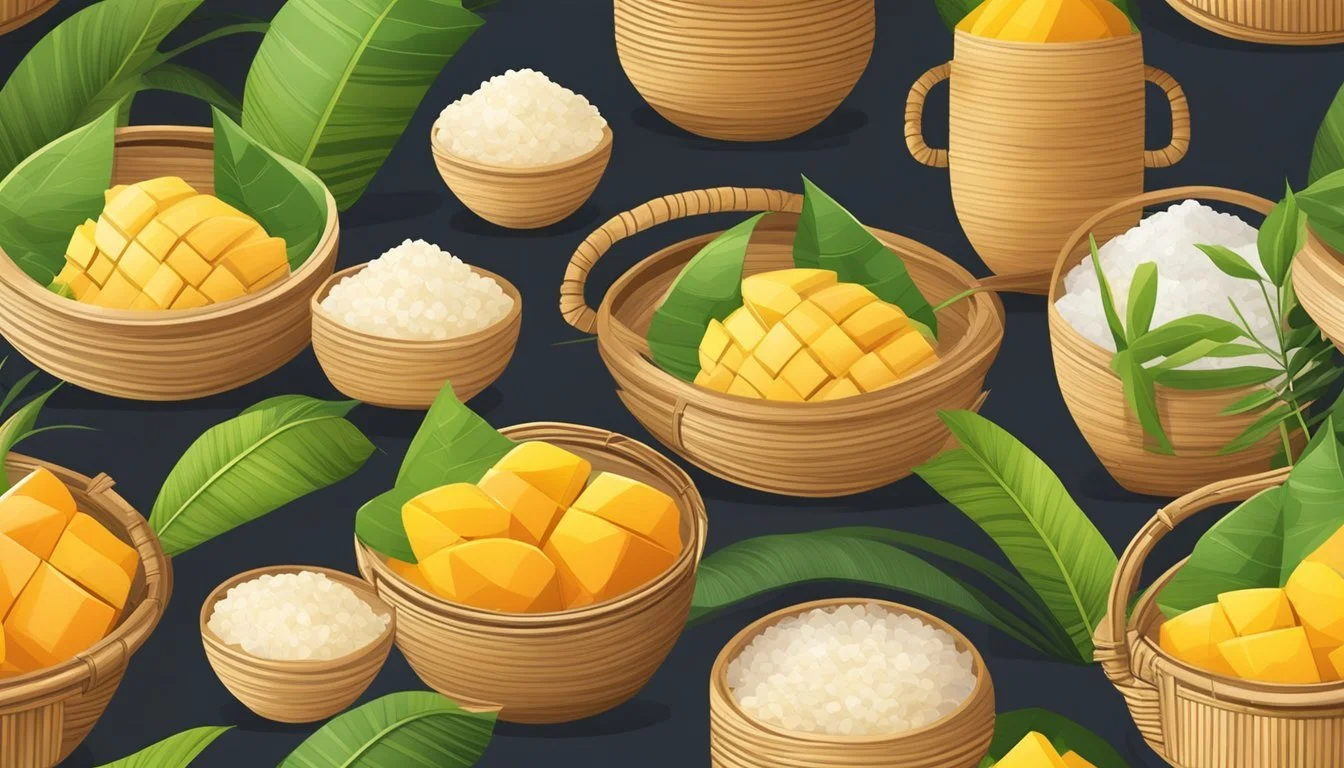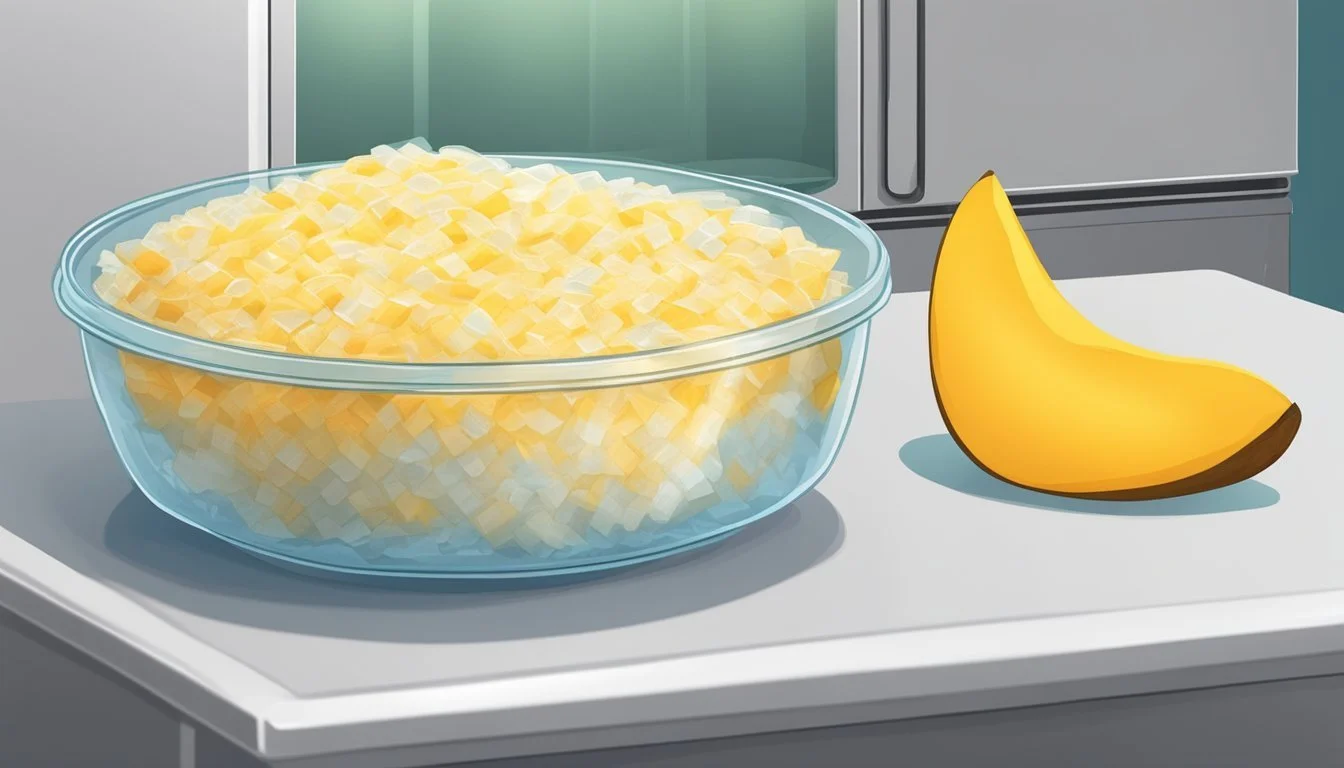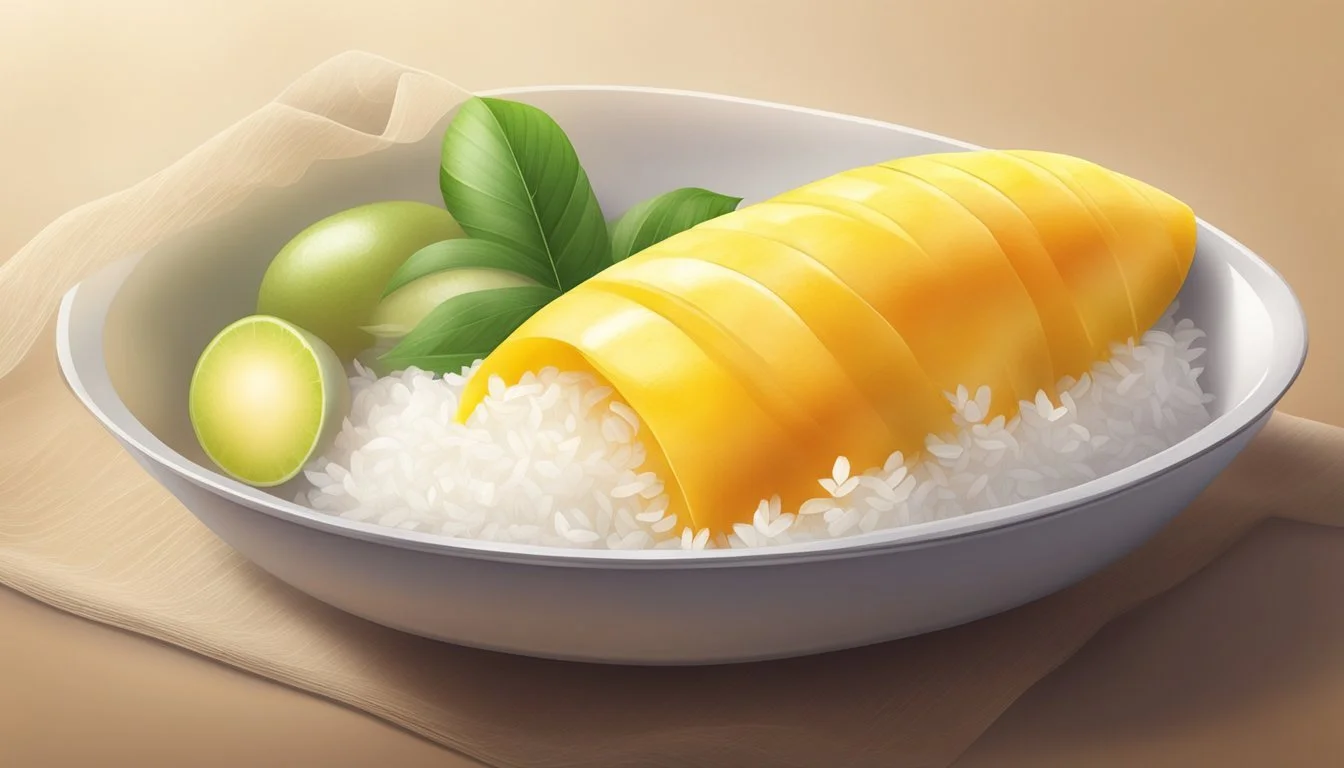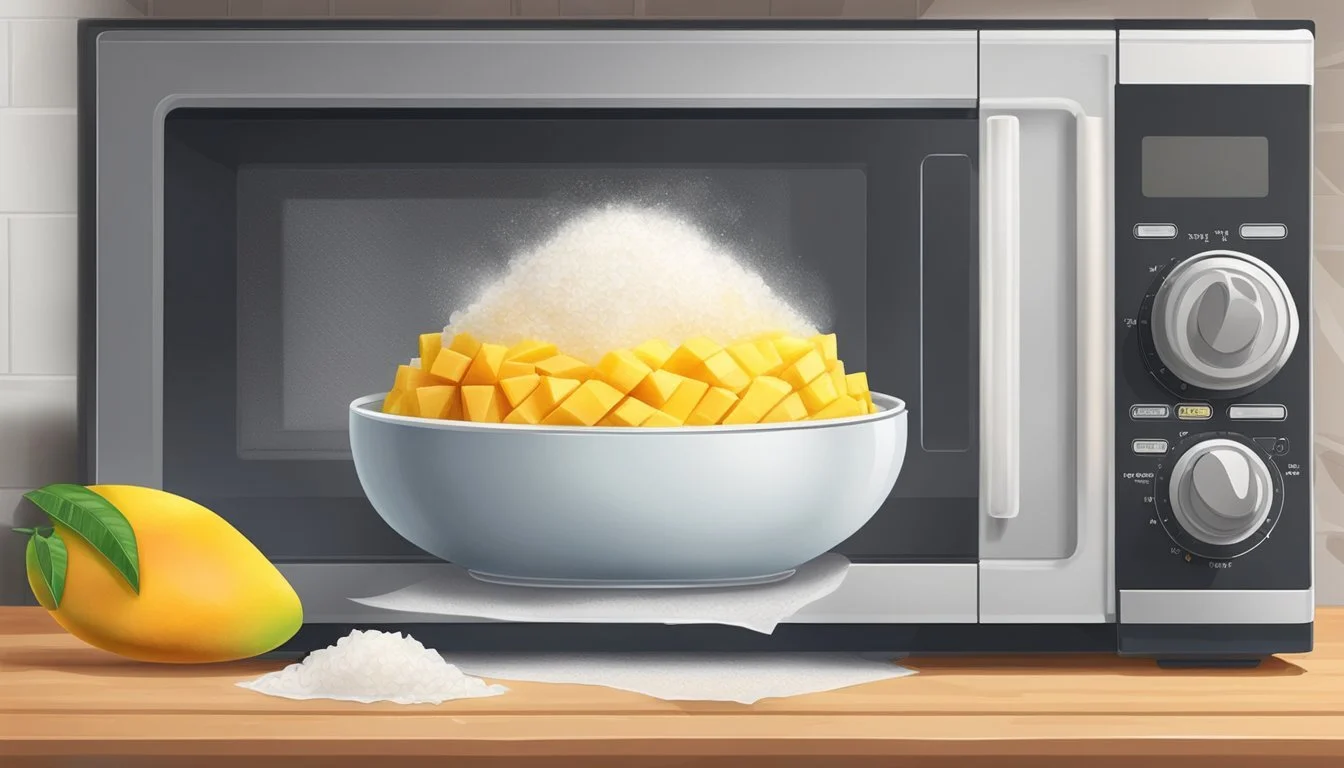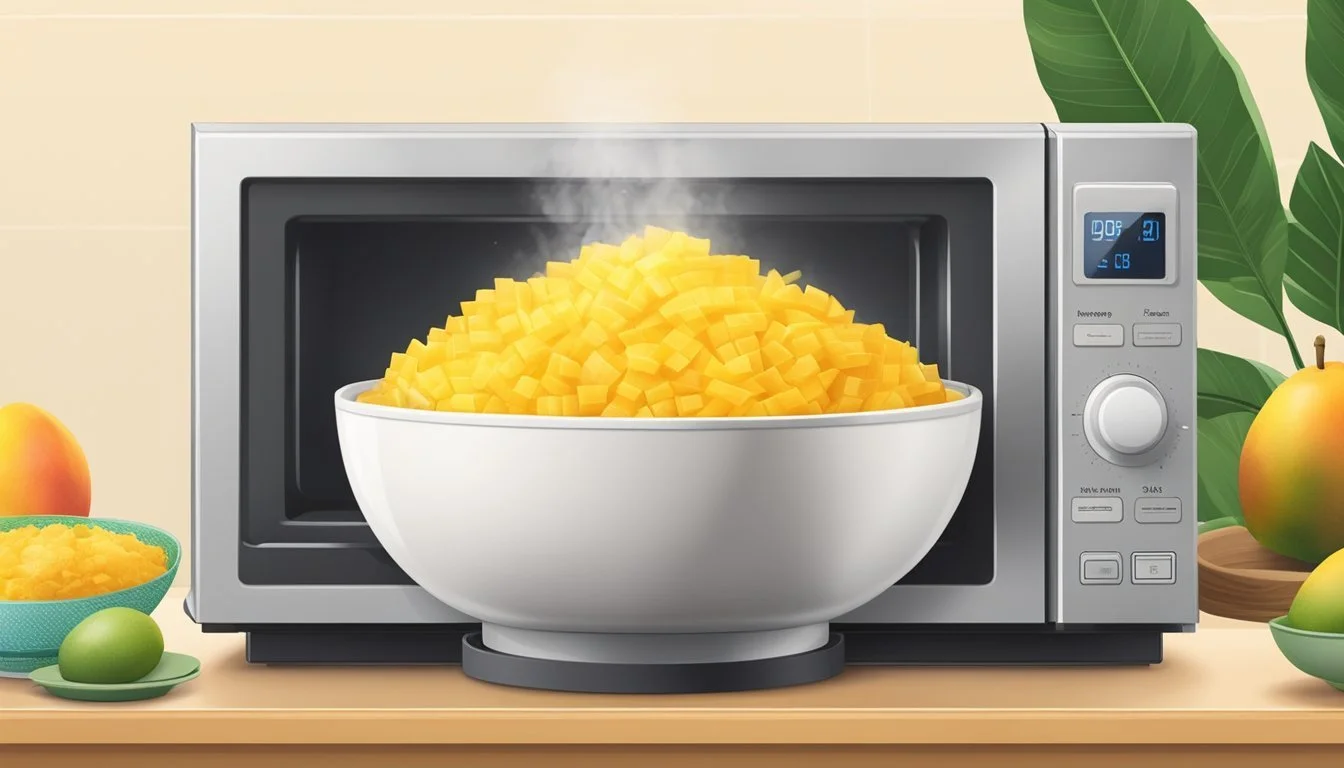Best Way to Reheat Mango Sticky Rice
Keeping It Soft and Fragrant
Mango sticky rice, a traditional Thai dessert known for its fragrant and sweet flavors, often leaves diners delighted long after the main course has ended. Yet, the challenges associated with reheating this dish can deter even the most avid food lovers from enjoying it a second time. The key to reviving the soft and sticky texture of leftover mango sticky rice (What wine goes well with rice?) lies in choosing the right reheating method that not only warms the dish but also preserves its delicate flavors and texture.
Several reheating methods stand out for their ability to restore mango sticky rice to its original splendor. Steaming is a popular option that gently warms the rice without making it mushy or drying it out, keeping the kernels plump and moist. Meanwhile, microwaving, when done correctly with a damp paper towel and an accompanying container of water, can also be a quick way to reheat the rice while maintaining its unique stickiness. For those looking to use the oven, covered dishes with a hint of added water helps in evenly distributing heat without sacrificing moisture. Each technique has its merits and choosing the best one relies on understanding the qualities of the rice and how these methods cater to maintaining its integrity.
Understanding Mango Sticky Rice
Mango sticky rice, known in Thai as ข้าวเหนียวมะม่วง (khao niew mamuang), is a traditional Thai dessert that combines sweet rice (also known as glutinous rice) with ripe mangoes and a rich coconut sauce. This dessert is cherished for its perfect balance of creamy, sticky, and sweet flavors paired with the fruity tang of fresh mangoes.
To prepare this dessert, chefs soak glutinous rice overnight and then steam it to achieve the characteristic soft and sticky texture. The rice itself has a neutral taste, which makes it a remarkable medium for absorbing the accompanying flavors.
Coconut milk, a crucial ingredient in mango sticky rice, is responsible for the dish's fragrant aroma and velvety consistency. When simmered with sugar and a pinch of salt, it transforms into a luscious sauce that envelopes the warm rice, enhancing its natural sweetness and creating a beautiful contrast between the textures.
The dessert is typically assembled with the prepared sweet rice placed on a plate, accompanied by slices of ripe mango. The quality and ripeness of the mango add a refreshing zest to the dish and are vital for the overall sensory experience.
Key Components Description Glutinous Rice The base of the dessert, known for its sticky texture. Coconut Milk Adds creaminess and a rich fragrance to the dish. Mango Provides a juicy and sweet contrast to the rice.
Mango sticky rice is revered not only for its delightful taste but also for its simple yet appealing presentation, making it an iconic symbol of Thai dessert craftsmanship. Each component works harmoniously to create a dessert that is loved for its straightforward, yet indulgent qualities.
Ingredients Breakdown
The quality of mango sticky rice hinges on a deft balance between the right ingredients and their complementary textures and flavors. This section provides an in-depth look at the components that ensure mango sticky rice is soft, fragrant, and delectably sweet.
Essentials for Mango Sticky Rice
The foundation of this dish is glutinous sticky rice, which is high in carbohydrates and known for its chewy texture. Properly cooked, it serves as a neutral base that is ready to absorb the flavors incorporated through the other ingredients. The use of ripe mangoes is crucial; they should be sweet and high in fiber and vitamin C, contributing not just flavor but also nutritional value. Mangoes must be at the peak of ripeness to ensure natural sweetness and soft texture.
Texture-Enhancing Additives
To achieve the dish's characteristic softness and to prevent the rice from hardening when reheated, consider incorporating coconut cream. High in fat, coconut cream enhances the rice's texture and imparts a rich, creamy consistency. A pinch of salt can enhance and balance the overall flavors, while also affecting the dish's texture significantly.
Sweetness Variables
A proper balance of sweetness is essential. For this, a variety of sweeteners can be used. Sugar is the most common, ideal for subtly increasing sweetness without overpowering the dish's delicate flavors. Additionally, the coconut cream becomes both a texture and sweetness variable, as it often brings its own sugary notes to complement the rice and mango.
Fruit and Garnish Options
The star fruit of the dish, mango, should be presented in its most vibrant and ripe form—the sweeter and more aromatic, the better. As for garnishes, toasted sesame seeds can add a nutty contrast and enhance the texture with a gentle crunch. They also accentuate the dish with a slight earthiness while not deterring from the overall sweet and soft profile of the mango sticky rice.
Storing Mango Sticky Rice
Proper storage is crucial for maintaining the quality of mango sticky rice. Whether one chooses to refrigerate or freeze the leftovers, using an airtight container is key to preserving the dish's texture and flavor.
Refrigeration Tips
When storing mango sticky rice in the refrigerator, it should first be allowed to cool to room temperature. This prevents condensation that could make the rice soggy. Once cooled, the rice should be transferred into an airtight container to keep out moisture and other flavors from the refrigerator. The airtight container helps maintain the soft and fragrant texture of the sticky rice. Mango sticky rice stored in the fridge is best consumed within 1-2 days to enjoy its optimal flavor.
Cooling Down: Allow the rice to cool for about 15-20 minutes.
Airtight Container: Transfer the sticky rice to an airtight container.
Duration: Consume refrigerated mango sticky rice within 1-2 days for best taste.
Freezing Guidelines
For longer storage, one can freeze mango sticky rice. Freezing should be done in the same airtight container to protect the texture and aroma during the freezing process. To freeze mango sticky rice, ensure that all components are separate, with the mango slices stored in individual freezer-safe bags or containers. The rice can be thawed at room temperature or in the refrigerator, and one must be cautious when reheating to avoid drying out the rice.
Separation: Store the rice and mango slices separately in freezer-safe bags/containers.
Freezing Period: Mango sticky rice can be frozen for up to 1 month.
Thawing Process: Thaw in the refrigerator or at room temperature.
Reheating Fundamentals
When reheating mango sticky rice, preserving its delicate texture and aromatic nature is crucial. Different reheating methods can yield varying results, but each has techniques to maintain the quality of the rice.
Microwave Reheating
Using a microwave is a quick and efficient way to reheat sticky rice. The key steps involve:
Spreading the rice in an even layer on a microwave-safe plate.
Covering it with a damp paper towel to introduce moisture and prevent drying out.
This method is convenient, especially if one is short on time.
Steaming Techniques
Steaming is a traditional approach that can gently reheat the rice while retaining its softness:
A bamboo steamer or steamer basket is preferred.
Ensure the rice does not contact the water by placing it above the simmering water in the steamer.
Steaming allows for even heat distribution without sapping the moisture from the rice, making it an excellent choice for maintaining the original texture.
Oven Method
For those favoring the oven, these instructions help avoid dryness:
Preheat the oven to a low temperature, around 300°F (150°C).
Place the rice in an oven-safe dish with a few tablespoons of water, mixing gently.
Cover the dish tightly with aluminum foil before heating.
This method spreads heat evenly, slowly bringing the rice back to a desirable temperature.
Skillet Warming
Skillet warming is a practical way to reheat rice on the stovetop:
Use a non-stick skillet over medium-low heat with a bit of water or coconut milk.
Stir the rice frequently to prevent sticking and promote even warming.
Skillet warming works well for smaller portions and can quickly bring back the warmth and fragrance of mango sticky rice.
Maintaining Perfect Texture
When reheating mango sticky rice, maintaining its soft and chewy texture is paramount. The methods below utilize different heating techniques to ensure the rice's texture is preserved and that the grains absorb moisture appropriately.
Steaming for Softness
Steaming is the preferred method for preserving the delicate texture of mango sticky rice. It allows the grains to absorb moisture without becoming mushy.
Setup: Set up a steamer or construct one by placing a colander over a pot of simmering water. Ensure the water does not touch the colander.
Process: Place the sticky rice in the colander, cover, and steam until it becomes soft and warm.
Microwave Moisture Retention
Microwaving sticky rice can retain moisture if done carefully, ensuring the rice stays chewy and pleasant.
Preparation: Spread the rice on a microwave-safe dish.
Moisture: Cover with a damp paper towel to add moisture during heating.
Heating:
Heat at medium power in 30-second intervals.
Stir between intervals to distribute heat.
Skillet for a Crispy Edge
For those who enjoy a slightly crispy edge to their mango sticky rice, using a skillet can enhance the texture.
Preparation: Preheat a skillet over medium heat.
Process:
Add the rice with a small amount of coconut milk to prevent sticking and to add richness.
Stir gently until the rice is heated through and slightly crispy on the edges.
By choosing the appropriate method, one can enjoy reheated mango sticky rice that retains its signature soft and fragrant texture.
Ensuring Ideal Flavor
Proper reheating of Mango Sticky Rice not only involves achieving the right temperature but also preserving the dish's distinctive flavor profile, with a focus on its characteristic sweet and savory harmony and the aromatic qualities of the coconut and mango.
Balancing Sweetness and Saltiness
To retain the ideal balance between sweetness and saltiness is critical to reheat the dish without altering its essential flavors. When reheating in a saucepan or using another method, one should avoid adding extra sugar or salt unless necessary. If the rice tastes less sweet after reheating, a small quantity of granulated sugar, palm sugar, or white sugar can be mixed into the coconut sauce before drizzling it over the rice. On the other hand, if the rice requires a hint of saltiness, one can lightly season the salted coconut sauce to accentuate the flavors without overpowering the delicate sweetness.
Enhancing Coconut and Mango Notes
Maintaining the fragrant coconut aroma and the fresh taste of mango is essential for an authentic Mango Sticky Rice experience. When reheating, it's advisable to use the same coconut sauce that accompanied the original dish to help boost the coconut flavor that may have diminished. If the coconut sauce has thickened, thinning it with a bit of water can help bring back the right consistency and enhance its scent. For the mango, if it's served at room temperature, its natural flavors will be more pronounced, complementing the warm, soft texture of the heated sticky rice.
Presentation Tips
When reheating mango sticky rice, the presentation is as crucial as the taste. The aim is to create a visually appealing dish that complements the sweet and fragrant nature of the rice.
Serving Suggestions
For serving, one should gently mound the sweet sticky rice in the center of a plate or a small bowl, creating a pleasing base for the toppings. Slicing the mango into thin, uniform pieces and arranging them artistically around or atop the rice accentuates the dish's vibrant color and freshness. To elevate the experience, one can drizzle a spoonful of warm coconut cream over the sticky rice, allowing it to pool slightly on the plate for both visual and taste appeal.
Garnishing Techniques
The final touch involves garnishing, which should align with the flavors of the dish. Sprinkling a small amount of toasted sesame seeds over the rice gives a subtle nutty flavor and an appealing contrast in texture. Additionally, adding a few mango pieces to the top can reinforce the tropical flair. A light zest of lime can also be considered to add brightness to the dish without overpowering the other components.
Additional Tips and Variations
When reheating mango sticky rice, certain adjustments and considerations can enhance the dish's quality. Proper ingredient selection and an awareness of nutritional content can make a significant difference.
Alternative Ingredients
Coconut Milk: For a richer flavor, one can use full-fat canned coconut milk instead of light versions. The thickness of full-fat coconut milk adds to the creamy texture of the rice. A dash of cornstarch mixed into the coconut milk can help maintain the desired consistency if it becomes too watery.
Rice Varieties: Though Thai sweet rice or jasmine rice are traditionally used for their fragrance and texture, substitutions like sushi rice or generic sweet rice can be utilized. These alternatives may slightly alter the outcome but should still be soaked prior to cooking to ensure softness.
Serving Size and Calories
Serving Size: A standard serving of mango sticky rice is typically 1 cup of cooked rice with slices of mango.
Calories: On average, this serving size contains approximately 400-500 calories, with variance based on the use of additional sweeteners or toppings.
To manage caloric intake, smaller portions can be served, especially if the sticky rice is only a part of a larger meal. It's also important to note that the caloric content mainly comes from the rice and the coconut milk, which contribute starch and fat respectively.
Exploring Cultural Significance
Mango sticky rice not only tantalizes the palate but also carries a deep cultural heritage within Thai cuisine. It is a dish that reflects authenticity and the seasonal nature of Thai desserts.
Thai Cuisine and Desserts
Thai cuisine is celebrated for its harmonious blend of sweet, sour, salty, and spicy flavors, with desserts playing a crucial role in the culinary experience. Thai Mango Sticky Rice, known in Thailand as Khao Niew Mamuang, is a classic Thai dessert that typically appears during mango season. This dessert consists of glutinous rice with sweet coconut milk and ripe mango slices, creating a refreshing and nutty treat that's authentic to Thai food culture. Traditionally, one can find this dish at Thai restaurants or from street vendors, especially when mangoes are at their peak ripeness.
Ingredients:
Glutinous rice: The foundation of the dish, providing a sticky and chewy texture.
Mango: Adds a sweet and refreshing element.
Coconut milk: Infuses the rice with rich, creamy flavor.
In Thailand, mango sticky rice is more than just food; it is a symbol of the country's rich agricultural landscape and is intricately tied to ceremonial and festive occasions.
Global Variations
As Thai cuisine has traveled, mango sticky rice has been embraced and adapted by different cultures. In countries like Vietnam, similar desserts such as Xôi xoài can be found, which evidences the cross-cultural appreciation of sticky rice paired with mango. Asian grocers around the world now stock the necessary ingredients, allowing the dish to become a global favorite made by people in their homes. Variations might alter the sweetness or texture but the essence of combining sticky rice with mango remains a universal delight.
Adaptations:
Increased sweetness: Adjusted to local palates.
Mixed fruits: Some variations include additional tropical fruits.
Although different places might offer their unique take on this dessert, the essence of Thai Sticky Rice rests in its simplicity and the quality of its ingredients. As it continues to be revered both in Thailand and abroad, mango sticky rice remains a testament to the ongoing dialogue between traditional authenticity and contemporary global tastes.
Advanced Techniques
In this section, readers will discover specialized methods to refine the reheating process of mango sticky rice, ensuring it retains its delightful softness and aroma.
Cooking Sticky Rice
For the cooking of sticky rice, which is the fundamental element of the mango sticky rice dessert, one must select the rice with precision. Long-grain rice, notably varieties that are starchy and cling together when cooked, is the best choice for achieving the authentic texture. The rice should first undergo a process of soaking—typically from four hours to overnight—which aids in the absorption of moisture and results in more tender grains after cooking.
The cooking itself is optimally done using a steamer, with a bamboo steamer being traditionally favored. The permeable nature of bamboo allows for even distribution of steam, which gently cooks the rice while preserving its aromatic qualities. Here's a sequential guide:
Soak the long-grain rice for at least 4 hours.
Drain the rice and distribute it in the bamboo steamer.
Fill the bottom of a pot with water, making sure it doesn’t touch the bottom of the steamer.
Place the steamer on the pot and cover with the lid.
Steam for approximately 20 minutes or until the rice is tender and translucent.
Learning Traditional Methods
Adopting traditional techniques can significantly enhance the overall quality of a Thai meal. When reheating mango sticky rice, one can utilize tools such as the instant pot for a modern take on the traditional steaming method. The instant pot can replicate a steaming environment that is controlled and consistent, producing results akin to the traditional steamer.
Durian—a fruit known for its potent aroma—is sometimes incorporated into sticky rice dishes for an adventurous twist. If one is experimenting with durian or other flavors, they must ensure that the reheating process doesn’t diminish the ingredient's integral qualities. Here is how one can maintain the nuanced flavors during reheating:
Place the mango sticky rice in the instant pot using the pot-in-pot method.
Add water to the main pot and place the insert with the rice above it.
Set the instant pot on the 'Steam' setting and reheat for a few minutes, being cautious not to overcook.
By employing these advanced techniques and respecting the intrinsic qualities of the ingredients, one can masterfully reheat mango sticky rice, preserving its desired soft and fragrant texture.
Health Considerations
When reheating mango sticky rice, one must consider the nutritional profile of the dish and how dietary restrictions or allergies can impact its consumption. It's essential to be aware of the ingredients and their health implications for different individuals.
Nutritional Information
Mango sticky rice primarily consists of carbohydrates due to the rice and sugar present in the dish. The sticky rice, known for its high amylose starch content, offers a source of energy but should be consumed in moderation for individuals monitoring their caloric intake. A typical serving provides a substantial amount of calories. The mango, on the other hand, adds nutritional value by providing dietary fiber and vitamin C. Here's a brief overview of the key nutritional elements:
Carbohydrates: A primary source of energy, but excessive consumption can lead to weight gain.
Calories: Moderate to high in calories; portion control is advised.
Fiber: Found in the mango, beneficial for digestive health.
Vitamin C: Present in mangoes, important for immune function.
Amylose: A type of starch in sticky rice that can affect the texture and digestion process.
Allergy and Dietary Adjustments
Mango sticky rice is gluten-free, making it suitable for those with celiac disease or gluten sensitivity. However, individuals with a known allergy to mangoes should avoid this dish. Those adhering to a low-carbohydrate or calorie-restricted diet might consider consuming smaller portions due to the high carbohydrate and calorie content. Here are adjustments to consider for specific dietary needs:
Gluten-Free: Naturally gluten-free; suitable for those with celiac disease.
Carbohydrate Controlled: Consider smaller portions to reduce carb intake.
Calorie Conscious: Portion control is necessary due to the calorie density of the dish.
Dairy-Free: Typically dairy-free, but always check for added ingredients that may contain dairy.
When reheating, these health considerations remain as pertinent as during the initial preparation, and adjusting portion sizes may be necessary for maintaining a balanced dietary intake.

